Nawalparasi: The Tharu people are an ethnic group native to the Terai region of Nepal and northern India. They have their own distinct culture, language, and traditions. Historically, the Tharu have been marginalized and oppressed by the dominant groups in the region, but in recent years there have been efforts to promote and preserve Tharu culture and rights.
The Tharu people have a rich and diverse culture, with many unique traditions and customs. They have their own language, which is part of the Kiranti language family, and have a strong oral tradition. The Tharu people have a strong connection to the land and the natural environment, and many of their customs and rituals are centered around agriculture and the changing seasons.
The Tharu people have traditionally been farmers, but many have also been involved in trade and labor. They have their own unique system of social organization, with a strong emphasis on community and extended family.

In recent years, there have been efforts to promote and preserve Tharu culture and rights. This includes the recognition of the Tharu language in schools, the establishment of Tharu cultural centers, and the promotion of Tharu cultural heritage. However, the Tharu people still face many challenges, including poverty, lack of access to education and healthcare, and discrimination. There are different sub-groups of Tharu people with different cultural practices, living in different parts of Nepal and India. Some of them are Rana Tharu, Dangaura Tharu, Chitwan Tharu, and so on.
Types of Tharu Caste
In Nepal, the Tharu people are traditionally divided into several different castes or sub-groups, each with their own distinct customs and traditions. Some of the main Tharu castes in Nepal include:
- Rana Tharu: This is one of the largest and most influential Tharu castes, and is found primarily in the western Terai region of Nepal. They are known for their elaborate wedding rituals and traditional music and dance.
- Dangaura Tharu: This caste is found primarily in the Dang and Deukhuri valleys of western Nepal. They have a rich oral tradition and are known for their traditional storytelling and folktales.
- Chitwan Tharu: This caste is found primarily in the Chitwan district of central Nepal. They are known for their traditional agricultural practices and their use of indigenous medicine.
- Koila Tharu: This is a sub-group of the Rana Tharu and is found primarily in the Kailali and Kanchanpur districts of western Nepal. They are known for their traditional music and dance.
- Dhangad Tharu: This is a sub-group of the Rana Tharu and is found primarily in the Dhangadhi area of western Nepal. They are known for their traditional music and dance.
- Bote/Bote-Majhi: This is a sub-group of the Tharu people and is found primarily in the Bardiya and Kailali districts of western Nepal. They are known for their traditional music and dance.
- Santhal: This is another sub-group of the Tharu people, found in the eastern Terai region of Nepal. They are known for their traditional agricultural practices and their use of indigenous medicine.
- Routar Tharu: is a sub-group of the Tharu people found primarily in the eastern Terai region of Nepal, in the districts of Saptari, Siraha and Udayapur. They are also known as Rautahat Tharu. They have their own distinct culture, language and traditions, different from other Tharu sub-groups. They are known for their traditional music and dance, and for their strong community and extended family ties. Routar Tharu have traditionally been farmers, but many have also been involved in trade and labor. They have their own unique system of social organization. Like other Tharu sub-groups, the Routar Tharu also face many challenges, including poverty, lack of access to education and healthcare, and discrimination.
It’s important to note that these castes are not rigid, and many people may identify with multiple castes. Also, there might be variations in the names, customs, and traditions of these castes as it can vary from regions to regions.
Festivals of Tharu People
The Tharu people of Nepal have a rich cultural tradition and celebrate a variety of festivals throughout the year. Some of the main festivals celebrated by the Tharu people include:

- Maghi: This festival is celebrated in January and marks the end of the month of Poush and the beginning of the month of Magh. It is a time for family reunions, and people gather to sing and dance.
- Holi: This festival is celebrated in March and marks the arrival of spring. It is a time for people to forget past grudges and to forgive and forget. Holi is celebrated with lots of colors, music, and dancing.
- Chhath: This festival is celebrated in October/November, and is a time to give thanks to the sun god for a good harvest. It is celebrated with offerings of food and prayers to the sun god.
- Dipawali: This festival is celebrated in October/November, and is a time to celebrate the victory of good over evil. The festival is marked by the lighting of clay lamps and the exchange of sweets and gifts.
- Bala Chaturdashi: This festival is celebrated in October/November and is a time to remember and honor ancestors. It is marked by offerings of food and prayers to the ancestors.
- Sakela: This festival is celebrated by different Tharu sub-groups in different times of the year, but generally in the month of June-July. It is a time for singing and dancing, and for the exchange of gifts.
- Maghi Sakela: This festival is celebrated by Rana Tharu in the month of January/February. It is a time for singing and dancing, and for the exchange of gifts.
- Chhath Sakela: This festival is celebrated by Dangaura Tharu, in the month of October/November. It is a time for singing and dancing, and for the exchange of gifts.
These are some of the main festivals celebrated by the Tharu people of Nepal, but there are also many other festivals and local traditions that vary from region to region, and from one sub-group to another.
Foods of Tharu people
The Tharu people of Nepal have a unique and diverse cuisine, heavily influenced by their agricultural lifestyle and the local flora and fauna of the Terai region. Some of the main foods of the Tharu people include:
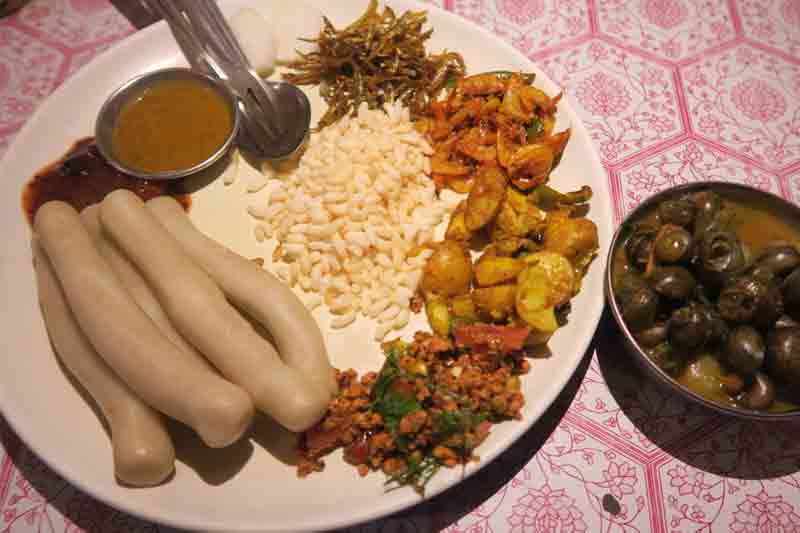
- Dhindo: This is a traditional Tharu staple food made from a mixture of corn and millet flour. It is typically served with a variety of curries and vegetable dishes.
- Bagiya: This is a type of fried bread made from a mixture of rice and wheat flour. It is typically served with curries or as a snack.
- Chura: This is a type of flattened rice that is often eaten as a breakfast food. It can be served plain or with a variety of toppings such as curd, sugar or honey.
- Sel Roti: This is a traditional Nepali sweet made from rice flour and sugar. It is deep-fried and is often served as a dessert or as a snack.
- Dhikri: This is a type of steamed dumpling made from a mixture of rice flour and lentils. It is often served with curries or as a snack.
- Dhau: This is a traditional Tharu yogurt, which is made by curdling milk with a natural curdling agent. It is often served as a dessert or as a side dish.
- Tama: This is a traditional Tharu food made from the stem of a type of bamboo tree. It is often served with a variety of curries and vegetable dishes.
- Wild meat: Tharus are also known to consume wild meat from animals like deer, wild boar and other small mammals which are commonly found in the Terai region.
These are just a few examples of the many foods of the Tharu people. The Tharu people are also known to consume seasonal fruits and vegetables which are available in their local regions.
Cultural dress of the Tharu people
The Tharu people of Nepal have a distinct and colorful traditional dress, which is heavily influenced by their cultural heritage and the local climate of the Terai region. Some of the main elements of Tharu traditional dress include:

- Dhoti: This is a long piece of cloth worn by men around the waist, and is typically made from cotton or silk. It is often decorated with intricate embroidery or beadwork.
- Sari: This is a long piece of cloth worn by women, and is typically made from cotton or silk. It is wrapped around the waist and over the shoulder and is often decorated with intricate embroidery or beadwork.
- Cholo: This is a short blouse worn by women, and is typically made from cotton or silk. It is often decorated with intricate embroidery or beadwork.
- Pagri: This is a traditional headgear worn by men, and is made from cotton or silk. It is often decorated with intricate embroidery or beadwork.
- Jewelry: The Tharu women are known for their love of jewelry and are often seen wearing traditional ornaments made of silver and gold. They wear a variety of earrings, bangles, necklaces, nose rings and other ornaments.
- Accessories: The Tharu people also use various accessories like scarfs, shawls, belts, and bags to complete their traditional attire.
These are some of the main elements of Tharu traditional dress, but there are also many other variations and styles that vary from region to region, and from one sub-group to another. The traditional dress of Tharu people also depends on the occasion, be it a festival or a daily wear, it can vary accordingly.
Languages of Tharu people
The Tharu people of Nepal and India speak a language that belongs to the Kiranti branch of the Sino-Tibetan language family. The Tharu language has several dialects, which vary from region to region and from one sub-group to another.
The Tharu language is spoken in the Terai region of Nepal, and in the states of Uttarakhand, Uttar Pradesh, Bihar, and West Bengal in India. The script of the Tharu language has not been officially standardized, but it is written in the Devanagari script, which is also used for the Nepali language.
The Tharu language is an unwritten language for a long time, but in recent years, there have been efforts to preserve and promote the Tharu language through education, literature, and media. Some organizations and individuals have also been working to develop a standard writing system for the Tharu language.

Many Tharu people are also fluent in Nepali and Hindi, which are the official languages of Nepal and India respectively. In recent years, more and more Tharu people have been learning English as well.
It’s important to note that the Tharu language, culture, and customs are closely intertwined, and the preservation and promotion of the Tharu language is seen as an important aspect of preserving and promoting Tharu culture and identity.
Professions of Tharu people
The Tharu people of Nepal and India have traditionally been involved in agriculture, but in recent years, many Tharu people have diversified their professions. Some of the main professions of the Tharu people include:
- Agriculture: The Tharu people have a strong connection to the land and are skilled farmers. They grow a variety of crops such as rice, wheat, maize, lentils, and vegetables.
- Livestock rearing: Many Tharu people are also involved in raising livestock such as cattle, buffalo, sheep, and goats, which provide them with milk, meat, and other products.
- Forestry: The Terai region where the Tharu people live is rich in forest resources, and many Tharu people are involved in the collection and sale of forest products such as honey, medicinal plants, and timber.
- Fishing: Many Tharu people are also involved in fishing and aquaculture, which are important activities in the Terai region where the Tharu people live.
- Labor: With the development of the Terai region, many Tharu people have migrated to urban areas for work, and are engaged in various types of labor such as construction work, factory work, and domestic work.
- Trade: Many Tharu people are also involved in trade, both in the formal and informal sectors. They are known for their entrepreneurial spirit and are involved in various businesses such as shops, transportation, and small-scale manufacturing.
- Service Sector: With the growth of the service sector, many Tharu people have also been employed in the service sector such as tourism, banking, and other services.
- Self-Employment: Many Tharu people are also engaged in various forms of self-employment such as handicrafts, tailoring, and other cottage industries.
It’s important to note that the profession of Tharu people is not fixed, and many people may have multiple occupations or may change their occupation over time. Also, the profession of Tharu people may vary from regions to regions, and from one sub-group to another.
Rituals of Tharu people
The Tharu people of Nepal have a rich tradition of rituals and ceremonies, which are closely connected to their agricultural lifestyle and the natural environment. Some of the main rituals and ceremonies of the Tharu people include:
- Birth rituals: The Tharu people have a series of rituals that are performed at the time of birth, including the naming of the child, the shaving of the baby’s head, and the first feeding of the baby.
- Marriage rituals: The Tharu people have a series of elaborate marriage rituals that are performed over several days, including the engagement ceremony, the wedding ceremony, and the post-wedding rituals.
- Death rituals: The Tharu people have a series of rituals that are performed at the time of death, including the washing and shrouding of the body, the funeral procession, and the cremation or burial of the body.
- Agricultural rituals: The Tharu people have a series of rituals that are performed at various stages of the agricultural cycle, including the planting, harvesting, and storing of crops. These rituals are often performed to ensure a good harvest and to propitiate the gods and spirits of the land.
- Festivals: The Tharu people celebrate a variety of festivals throughout the year, which are often connected to the agricultural cycle, such as the Maghi, Chhath and Sakela. These festivals are often marked by singing and dancing, the exchange of gifts, and the offering of food and prayers to the gods and spirits.
- Ancestral rituals: The Tharu people also have a strong tradition of ancestor worship, and many rituals are performed to honor and propitiate the spirits of deceased ancestors.
- Healing rituals: The Tharu people have a rich tradition of indigenous medicine, and many rituals are performed to heal the sick and to propitiate the gods and spirits of health and healing.
These are some of the main rituals and ceremonies of the Tharu people, but there are also many other rituals and local traditions that vary from region to region, and from one sub-group to another.
About Tharu people dynasty
The Tharu people of Nepal have a rich history and cultural heritage, but they have not traditionally had kings or a centralized political system like many other ethnic groups in Nepal. The Tharu people have traditionally been organized into small, autonomous communities, and have had their own system of social organization and leadership.
In recent history, during the Rana dynasty rule, there were few Tharu leaders who were appointed as chief of their own community by the Rana rulers, but they were not considered kings.
After the fall of Rana dynasty, Tharu people have been represented by their own leaders in the democratic political system of Nepal. They have formed their own political parties, and have been actively involved in the political process of Nepal.
It’s important to note that the concept of kingship among Tharu people is not the same as in other traditional kingdoms of Nepal and the information about kings of Tharu dynasty is not well recorded in history.


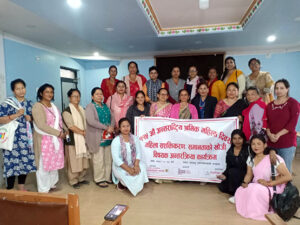
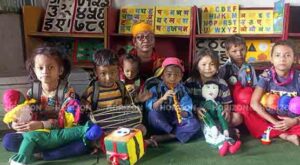

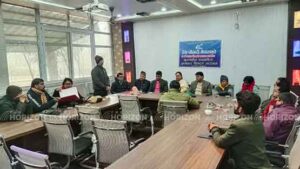
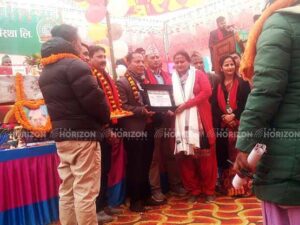

Be First to Comment